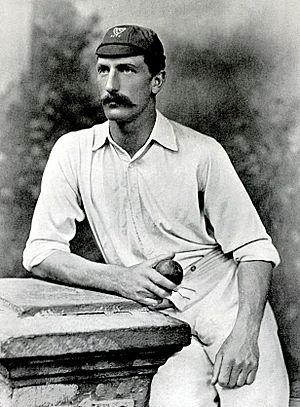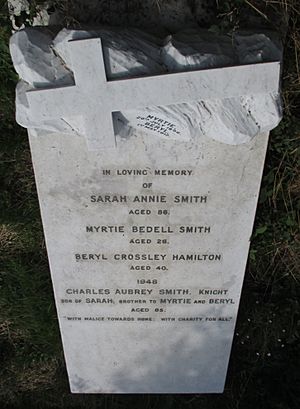C. Aubrey Smith facts for kids

Smith in about 1895
|
||||||||||||||||||||||||||||||||||||||||
| Personal information | ||||||||||||||||||||||||||||||||||||||||
|---|---|---|---|---|---|---|---|---|---|---|---|---|---|---|---|---|---|---|---|---|---|---|---|---|---|---|---|---|---|---|---|---|---|---|---|---|---|---|---|---|
| Full name |
Charles Aubrey Smith
|
|||||||||||||||||||||||||||||||||||||||
| Born | 21 July 1863 London, England |
|||||||||||||||||||||||||||||||||||||||
| Died | 20 December 1948 (aged 85) Beverly Hills, California, U.S. |
|||||||||||||||||||||||||||||||||||||||
| Batting | Right-handed | |||||||||||||||||||||||||||||||||||||||
| Bowling | Right arm fast | |||||||||||||||||||||||||||||||||||||||
| International information | ||||||||||||||||||||||||||||||||||||||||
| National side | ||||||||||||||||||||||||||||||||||||||||
| Only Test (cap 66) | 12 March 1889 v South Africa | |||||||||||||||||||||||||||||||||||||||
| Domestic team information | ||||||||||||||||||||||||||||||||||||||||
| Years | Team | |||||||||||||||||||||||||||||||||||||||
| 1882–1896 | Sussex | |||||||||||||||||||||||||||||||||||||||
| 1882–1885 | Cambridge University | |||||||||||||||||||||||||||||||||||||||
| 1889/90 | Transvaal | |||||||||||||||||||||||||||||||||||||||
| Career statistics | ||||||||||||||||||||||||||||||||||||||||
|
||||||||||||||||||||||||||||||||||||||||
|
Source: CricketArchive, 23 September 2008
|
||||||||||||||||||||||||||||||||||||||||
Sir Charles Aubrey Smith CBE (born July 21, 1863 – died December 20, 1948) was an amazing English gentleman! He was a talented cricketer who later became a famous stage and film actor. He was known for playing characters like officers and gentlemen, just like in the movie The Prisoner of Zenda (1937). When he moved to Hollywood, he even started a cricket team for other British actors, which really surprised the local Americans!
Contents
A Young Life
Charles Aubrey Smith was born in London, England. His father, Charles John Smith, was a doctor. Aubrey went to Charterhouse School and then to St John's College, Cambridge University.
In 1888, he went to South Africa to look for gold. While he was there, he got very sick with pneumonia. Doctors even thought he had died, but luckily, they were wrong! He got better and later married Isabella Wood in 1896.
Cricket Star
As a cricketer, Smith was mostly a fast bowler. This means he threw the ball very quickly. He was also a good batsman and a great fielder. He had a funny way of running up to bowl, which started far away from the wicket. This earned him the nickname "Round the Corner Smith."
He played for Cambridge University from 1882 to 1885. He also played for Sussex many times between 1882 and 1892.
Captain for England
While in South Africa, he was the captain of the Johannesburg English team. He even captained the England team in his only Test match! This was against South Africa in 1889. In that game, he took five wickets, which is a great achievement for a bowler. At the time, no one knew this match would become an official Test match in cricket history.
Hollywood Cricket Club
In 1932, Smith started the Hollywood Cricket Club in California. He even had special English grass brought in for the cricket pitch! He got many other famous British actors to join, like David Niven, Laurence Olivier, and Boris Karloff.
Smith was known for being very English. There's a funny story about him playing cricket in Hollywood. He dropped a difficult catch and asked his butler to bring his glasses. The butler brought them on a silver tray! The next ball was an easy catch, but Smith dropped it again. He took off his glasses and joked, "That silly man brought my reading glasses!"
Decades later, when he was a famous actor, someone saw him at Lord's cricket ground in England. One person said, "That man looks familiar." The other replied, "Yes, a chap named Smith. Used to play for Sussex." They didn't even realize he was a big Hollywood star!
Acting Career

Smith started acting on the London stage in 1895. His first big role was in Prisoner of Zenda in 1896, where he played two main characters. Many years later, in 1937, he appeared in a famous film version of the same story, this time as the wise old adviser.
He moved to Hollywood and became a very successful actor. He often played roles as an officer or a gentleman. He was seen as the unofficial leader of the British actors in Hollywood, a group sometimes called the "Hollywood Raj." This group included stars like David Niven, Ronald Colman, and Nigel Bruce.
Smith loved being known as Hollywood's "Englishman in Residence." With his bushy eyebrows, mustache, and tall height (6'2"), he was easy to recognize. He acted alongside many famous stars, including Greta Garbo, Elizabeth Taylor, Vivien Leigh, Clark Gable, and Laurence Olivier.
Some of his well-known films include The Prisoner of Zenda (1937), The Four Feathers (1939), and Alfred Hitchcock's Rebecca (1940). He also appeared in Dr. Jekyll and Mr. Hyde (1941) and And Then There Were None (1945). His last film role was in Little Women (1949), where he played the kind grandfather, Mr. James Laurence. He also played Jane's father in the first Tarzan film, Tarzan the Ape Man (1932), starring Johnny Weissmüller.
Later Life and Legacy
Smith passed away from pneumonia at his home in Beverly Hills on December 20, 1948, when he was 85 years old. His body was cremated, and his ashes were returned to England to be buried in his mother's grave in Hove, Sussex.
Honours and Awards
- Smith has his own star on the famous Hollywood Walk of Fame.
- In 1933, he was part of the first board for the Screen Actors Guild, which is a union for actors.
- He was made a Commander of the Order of the British Empire (CBE) in 1938.
- In 1944, he was knighted by King George VI. This means he became "Sir Charles Aubrey Smith" for his efforts in improving friendship between Britain and America.
See also
 In Spanish: Aubrey Smith para niños
In Spanish: Aubrey Smith para niños


